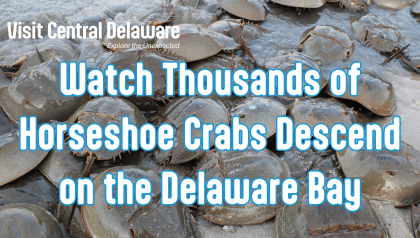

The Delaware Bay is home to the largest population of the American horseshoe crab — Delaware’s official state marine animal. These strange, prehistoric creatures have not changed their appearance or behavior for the last 450 million years. Every spring, thousands of horseshoe crabs descend on the shores of the Delaware Bay to spawn.
It’s quite a sight — here’s how you can see it!
WHEN DO HORSESHOE CRABS SPAWN?
The spawning season typically occurs in May and June, with the highest concentration around new and full moons and particularly during the nighttime high tide. Some of the best places to view the spawning are at Bowers Beach and the DuPont Nature Center in Milford. You can also see them at Pickering Beach and Kitts Hummock in Dover.
The spawning ritual begins with male crabs clustering along the shore as the considerably larger females arrive. Males often try to hitch a ride on a female’s shell to the high tide line. Females scurry on the shore, pausing every few feet to dig a hole and deposit as many as 20,000 eggs at a time. Males jockey to fertilize the eggs, and once complete, the crabs leave and waves wash sand over the nests.
When you go, be sure to wear boots or other sturdy footwear. If you see an upside-down crab, pick it up by the shell and flip it back over! Despite their size, horseshoe crabs are not dangerous — they primarily use their tails as rudders when swimming. And keep an eye out for the little green eggs! Later in the season, you may be able to see some developing eggs become clearer — you can easily see the tiny crab swimming inside at this point!
The peak season ends after June, so make sure to go before then. For more information, visit the Delaware Department of Natural Resources and Environmental Control website.
WHY DO SCIENTISTS STUDY HORSESHOE CRAB SPAWNING?
Horseshoe crabs are more than interesting creatures — they’re essential for human and environmental health. Spawning surveys ensure the population survives through horseshoe crab harvesting season, which helps keep us and the Delaware Bay ecosystem healthy.
WHY DO PEOPLE HARVEST HORSESHOE CRABS?
Did you know horseshoe crab blood is bright blue? That’s because it contains hemocyanin, a copper-based pigment that could be useful in cancer research and other lifesaving medical treatments.
Horseshoe crab blood also contains limulus amoebocyte lysate, a protein that causes the blood to clot when it comes into contact with bacteria. Biomedical companies use this clotting agent to ensure medical products like vaccines and internal prosthetics are safe.
Biomedical companies collect and bleed approximately 600,000 crabs annually. Typically, a bleeding session lasts about eight minutes, during which the crab loses roughly one-third of its blood. After returning to the ocean, the crab will regenerate the lost blood in about a week. However, an estimated 30% or more of these crabs die due to the bleeding process.
While synthetic alternatives to limulus amoebocyte lysate exist, laboratories in the U.S. have been slow to start using it. In many states, horseshoe crab harvesting has increased due to the pandemic. Delaware state law currently bans biomedical companies from harvesting horseshoe crabs for bleeding in the state’s spawning areas. Companies have also harvested horseshoe crabs for bait since the 1990s, contributing more to overharvesting than the medical industry. To protect the declining population, Delaware imposed a moratorium on harvesting female horseshoe crabs in late 2022. The law limits fisheries to a male-only harvest until experts can be certain overfishing won’t pose an ecological threat.
THE IMPORTANCE OF PRESERVATION
Preserving Delaware’s official marine animal is about more than keeping a living fossil alive. Horseshoe crabs are also a vital part of the Delaware Bay ecosystem.
For one thing, horseshoe crab eggs give migrating shorebirds like red knots and sanderlings the nutrients and energy they need to continue their Arctic journey. And creatures like mollusks and crustaceans attach to the horseshoe crab’s exoskeleton, which provides a traveling home for them. Many wildlife conservation agencies have launched initiatives to help the horseshoe crab population grow. For example, the Wetlands Institute collects fertilized horseshoe crab eggs and raises them in captivity. With no predators to worry about, more can survive their early stages of growth — meaning more crabs for the habitat. Once they’re old enough to be on their own, the Institute returns them to the ocean.
LEARN HOW YOU CAN HELP
If you want to help protect Delaware’s horseshoe crab population, you are more than welcome to get involved! Every year during the spawning season, hundreds of volunteers dedicate their evenings to counting horseshoe crabs all along the shores of the Delaware Bay. Have fun on a beach and meet like-minded people while supporting a great cause.
